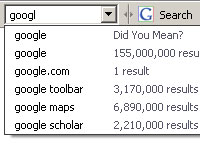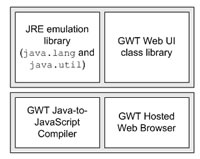 Back on Tuesday Google released their latest offering, the Google Web Toolkit (GWT). For those who didn’t catch the news at the time, it’s a downloadable application that lets developers write Java code that is translated into Javascript.
Back on Tuesday Google released their latest offering, the Google Web Toolkit (GWT). For those who didn’t catch the news at the time, it’s a downloadable application that lets developers write Java code that is translated into Javascript.
At first glance this appears a pretty strange concept, outputting JavaScript from Java, but code is the near-mythical AJAX code, heavily assisting the production of Web 2.0 applications.
You’ll know we think AJAX applications are special, not for the buckets of hype that’s surrounding Web 2.0, but because the taking up of AJAX marked the death Microsoft’s dominance of the interface. It’s the point where using an application through a Web browser became less tiresome because information is updated without the Web page having to be refreshed.
Google slowly remove the gloves
Google’s attacks on Microsoft have been consistently more intense. Early moves like the extended beta of Gmail chipping away at Microsoft’s Hotmail service.
The moves on to the Windows desktop via Google Desktop Search (GDS) stepped it up a gear. When we saw the release of GDS, we advised our friends to buy Google stock. This was the point where users no longer needed to use Windows Explorer to locate the documents that they had created on their machine. A Google application became the route to documents on ‘their’ platform. The vice-like grip in place for so many years was starting to weaken.
 The interface – Now they’re ready to box
The interface – Now they’re ready to box
We see the release of the Web Toolkit as Google’s most direct pop at Microsoft yet.
There is still a mystique around creating AJAX applications, primarily because most of the people who are trying to make them are not programmers, but are enthusiastic amateurs, designers, or people who have never learnt the basics of programming logic.
While GWT still requires programming skills in Java, there are more programmers around that know the inaccuracies that each version of browser requires, to have the interface working consistently.
It’s not just Microsoft that is getting a bloody nose from this, it’s also quite an aggressive move against Java, effectively removing its usefulness as a Web interface language. If this tool gets wide usage – and given the buzz (real or otherwise) around Web 2.0, it’s likely – it’s going to be pushing Java to the server, although many would argue that it doesn’t have much benefit there either.
 Summary I’ll leave you with the key point – Google Web Toolkit gives people the tools (literally) to write applications that work in any Web browser, circumvent Microsoft’s crown jewels, the Windows interface.
Summary I’ll leave you with the key point – Google Web Toolkit gives people the tools (literally) to write applications that work in any Web browser, circumvent Microsoft’s crown jewels, the Windows interface.
We know an AJAX toolkit won’t be a surprise to Microsoft, but it will be a big blow.